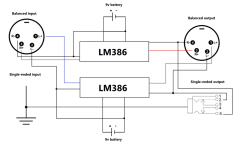So I am building a simple portable amplifier that has some peculiar setting as follows.
Amplified signal output from a DAC/AMP that has both balanced and single-ended outputs then goes into 2x LM386 boards, which are powered separately by 2x 9v batteries.
The amplified output signal needs to include 1x single-ended & 1x balanced (this is what I need). At the moment I am using 1x LM386 for each channel and L-/R- are shorted to input ground to create stereo output per the attached diagram (pardon my poor artistry skill).
The setup is running just fine, however since the 2 LM386 boards have to be separated at power supplies how would I wire them for an external DC supply? I guess sharing the same ground is impossible.
Additionally, is there any class D that can do half-bridge, or ground-referenced like the LM386 or TDA2030? I would like to improve run-time of the 9v batteries.
Amplified signal output from a DAC/AMP that has both balanced and single-ended outputs then goes into 2x LM386 boards, which are powered separately by 2x 9v batteries.
The amplified output signal needs to include 1x single-ended & 1x balanced (this is what I need). At the moment I am using 1x LM386 for each channel and L-/R- are shorted to input ground to create stereo output per the attached diagram (pardon my poor artistry skill).
The setup is running just fine, however since the 2 LM386 boards have to be separated at power supplies how would I wire them for an external DC supply? I guess sharing the same ground is impossible.
Additionally, is there any class D that can do half-bridge, or ground-referenced like the LM386 or TDA2030? I would like to improve run-time of the 9v batteries.
Attachments
Last edited:
You wrote 2x LM386 for each channel, but your sketch shows 2 times LM386 for two channels, so only one for each channel.
I would think partly how the balanced out is derived upstream and summing at the amp input with a buffer would help keep things at the signal level properly isolated.
I think the output is already not really balanced, and that that doesn't really matter because a headphone with balanced input can be driven unbalanced.
An LM386 has a balanced input, so you can just connect the positive input to the positive LM386 input and the negative input to the negative LM386 input. Maybe you have to modify the LM386 boards to disconnect the negative LM386 input from ground.
When you then AC couple the output of each LM386 to the corresponding positive pin of the output connector and ground the negative output connector pins, it should just work even though the output is actually unbalanced. The supplies can then be combined.
If you really want the output to be balanced, you could use four LM386's, swap the inputs of two of them (positive and negative inputs swapped) and use those LM386's to drive the negative output pins.
An LM386 has a balanced input, so you can just connect the positive input to the positive LM386 input and the negative input to the negative LM386 input. Maybe you have to modify the LM386 boards to disconnect the negative LM386 input from ground.
When you then AC couple the output of each LM386 to the corresponding positive pin of the output connector and ground the negative output connector pins, it should just work even though the output is actually unbalanced. The supplies can then be combined.
If you really want the output to be balanced, you could use four LM386's, swap the inputs of two of them (positive and negative inputs swapped) and use those LM386's to drive the negative output pins.
